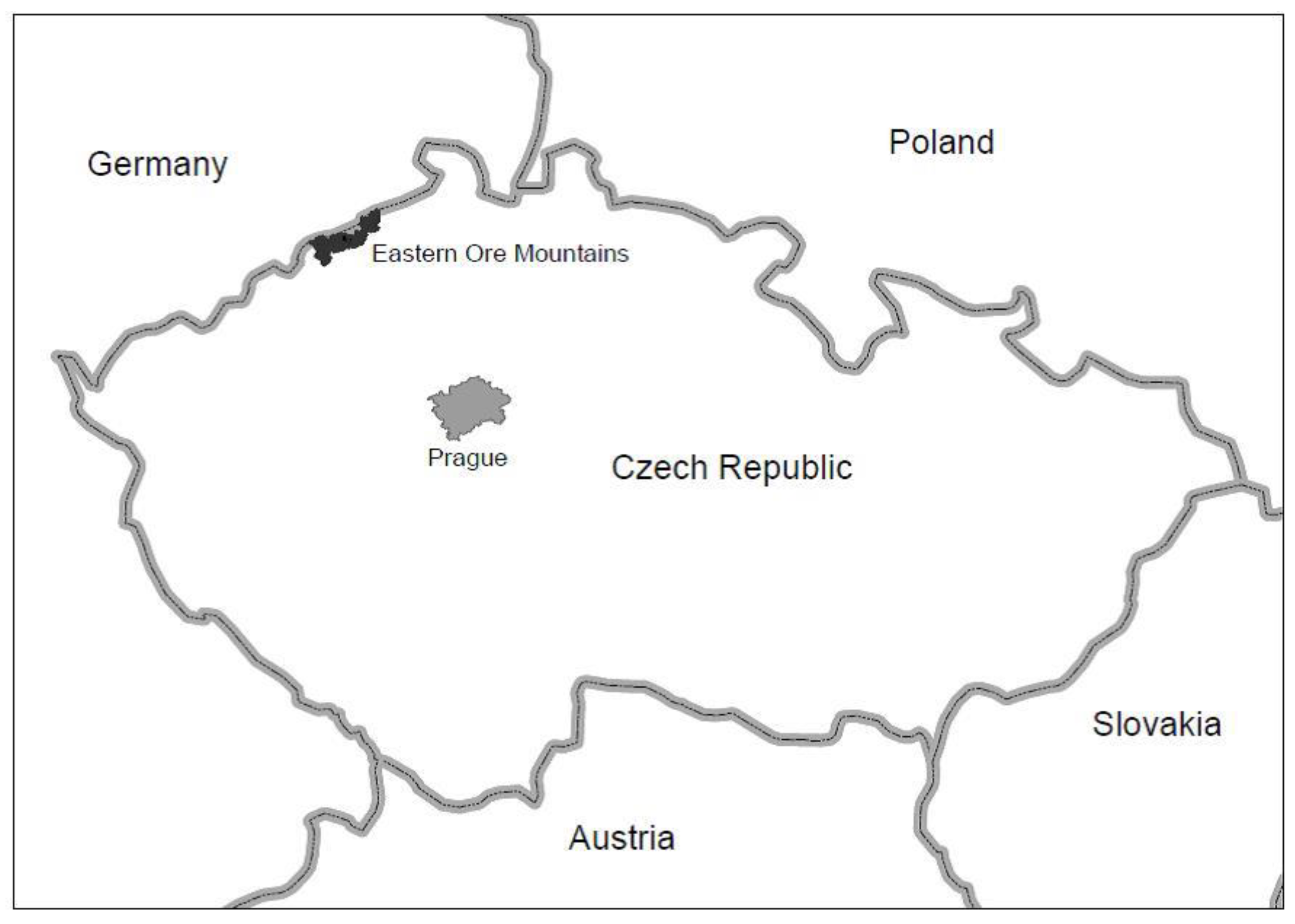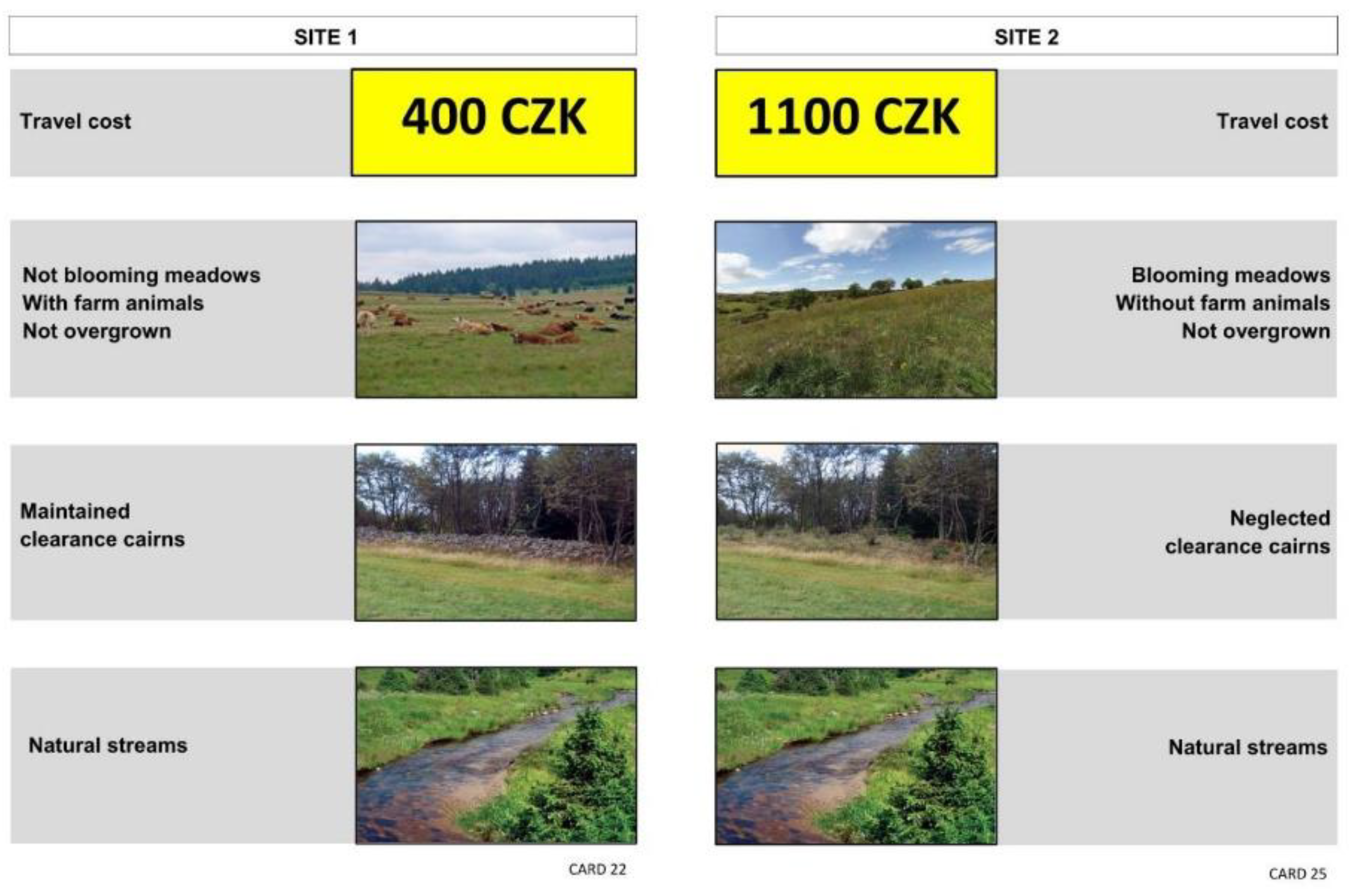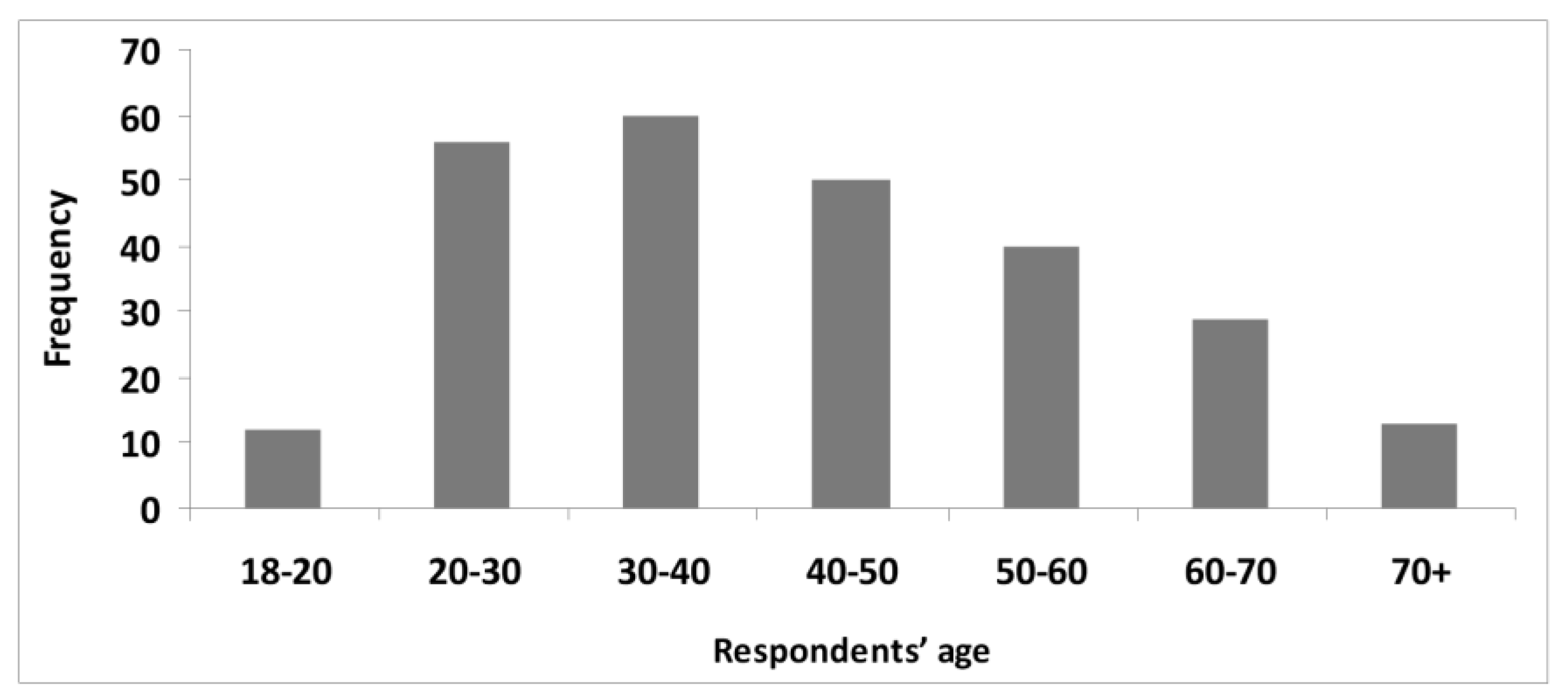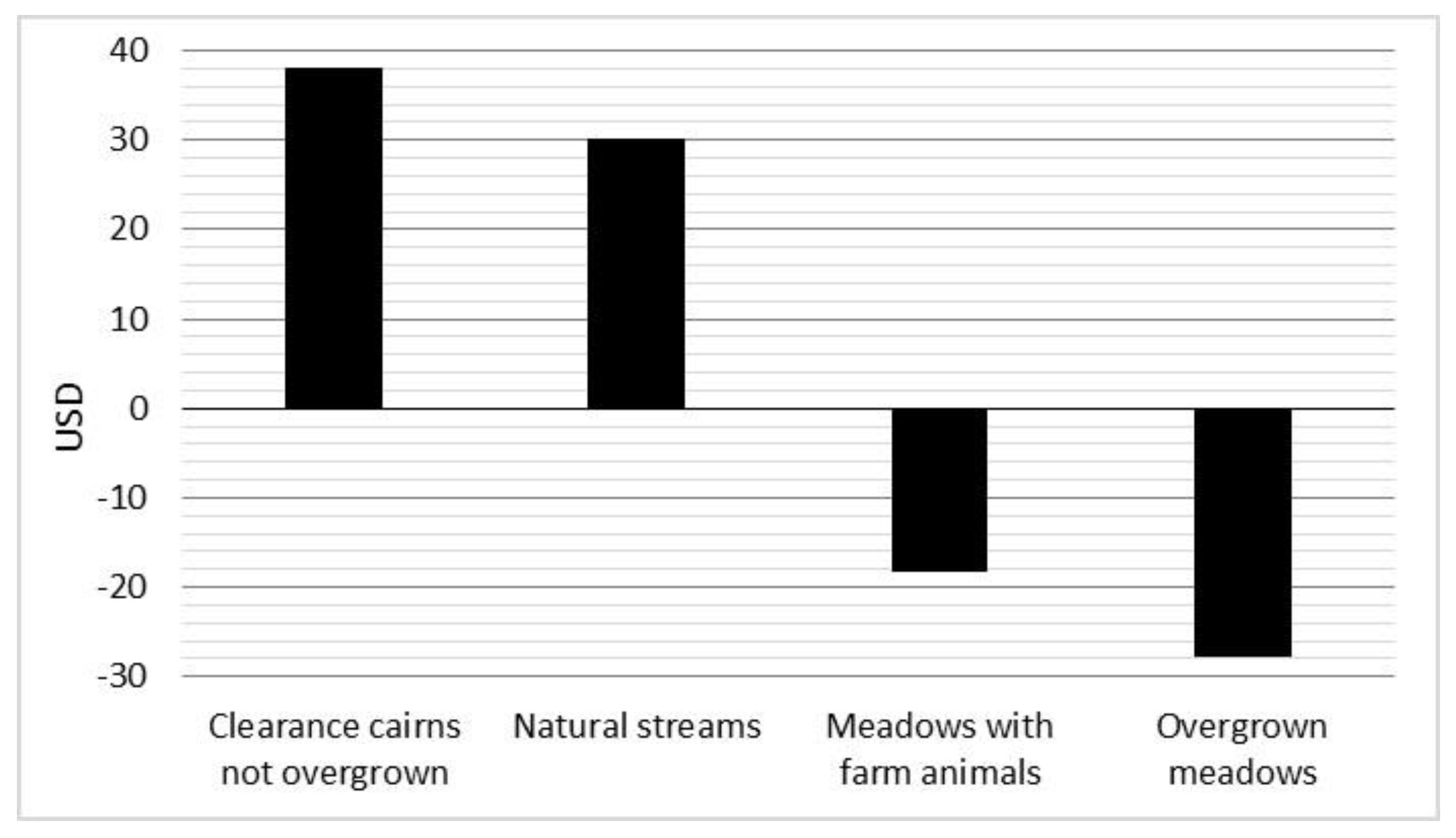Achieving Robust and Socially Acceptable Environmental Policy Recommendations: Lessons from Combining the Choice Experiment Method and Institutional Analysis Focused on Cultural Ecosystem Services
Abstract
1. Introduction
1.1. Multiple Methods for Analysis of Local Governance Systems
1.2. Aims and Objectives
2. Materials and Methods
2.1. Overview
2.2. Study Area
2.3. Choice Experiment—Data Collection, Survey Design and Data Analysis
2.4. Institutional Analysis—Data Collection Design
- Two out of the three environmental NGOs identified had terminated their activities and their representatives were unavailable.
- The nature protection undertaken by regional authorities is centralised, and one employee is responsible for numerous nature reserves.
- The Eastern Ore Mountains are rather sparsely settled with limited economic exploitation (mostly pasturing), so the interaction of potential stakeholders with the nature reserves is rather low.
3. Results
3.1. Choice Experiment—Sample Description and WTP Results
3.2. Institutional Analysis and Contextual Features
- Regional and state nature protectors: They possess capacities for nature protection and management. They do not support tourists seeing protected ecosystems—people can go elsewhere. They are convinced that available information and their communication with other stakeholders are sufficient—to do more is not their job (I2).
- Mayors/municipal representatives: They want to promote the mountains as a region with a high-quality environment, but they do not consider small-scale ecosystems and small nature reserves tools for increasing the attractiveness of the area (I1, I5). They have zero or limited information about them, and they do not want to interfere with nature protectors unless necessary (I4, I5). Further, I1 and I5 expressed negative attitudes against nature protection as undertaken in the Czech Republic—they see it only as an agenda incurring costs to other actors without offering any benefits/alternatives for development.
- Environmental NGO: According to I3, the NGO supplements the effort of the nature protectors in the region, but it does so mostly on small sites that it has bought out and manages as private reserves. Its resources come from private donors, and volunteering is an integral part of its efforts (this is also confirmed by evidence in [80]). I3 further stated that his organisation had wanted to gain public resources and to undertake the same activities in national reserves, but it had not succeeded in public calls. He said that he would encourage people to see protected ecosystems to value them even more (I3).
- Local entrepreneur: His interest is to re-develop a partly defunct mountain settlement, and he is contributing part of his profits to make it happen (launching a small zoo and tourist office next to his farm). He would support the development of new pathways around and through the nature reserves to attract more people. He has objections against the development approaches of municipal representatives from the lowlands that do not see mountain settlements as their priority (I7).
- Tourists: Based on the responses of 214 tourists gathered within the choice experiment survey, the majority visit the mountains repeatedly in one year and just for a one-day visit, mainly because the mountains are close and are a natural area. Prevailing activities during the summer are walking and cycling.
- Low participation: The decentralised efforts of local people (e.g., local NGO—I3; local entrepreneur—I7) to jointly address the environmental, economic and social sustainability of the area are apparent from their actions. Private resources and volunteering are important factors supporting these efforts. This is in strong contrast with plans of municipal representatives that view large (subsidised) infrastructural projects—such as skiing resorts—as the only means of development (I4, I1). There is also little communication between the state/regional nature protectors and local people’s initiatives, although they often have similar goals regarding the protection of the aesthetic beauty and biodiversity of the small-scale ecosystems (I6, I3).
- Bad image: There is a general bad image of state/regional nature protectors in the views of municipal representatives (I1, I5). They are not willing to continuously disseminate information or to work with the public to gain support for nature protection in the area. They mostly use power tools to conserve the existing protected land (I2, I8).
- In general, to initiate/support local cooperation and participation processes in order to develop a shared understanding of economic and environmental issues between decision makers (nature protectors, mayors, etc.) and citizens (including entrepreneurs and NGO representatives).
- In particular, to jointly develop a local sustainable development strategy based on ecosystem quality and capacities of local people and organisations (which are already in place). Do not rely excessively on external interventions (such as subsidies) to solve local problems.
3.3. Triangulation of Findings from the Choice Experiment and Institutional Analysis
- Decision makers at various levels should pursue a policy focused on small-scale ecosystem protection based on people’s stated preferences.
- Due to people’s clear sentiment towards the specific Eastern Ore Mountains countryside, local resources for biodiversity management support should be activated (especially regarding those small-scale ecosystems situated outside nature reserves and therefore enjoying no formal protection).
- The biodiversity protection model in the area should be built on participatory principles—local people should be treated as insiders of the planning and management processes.
- The interest in and acceptance of the biodiversity protection of small-scale ecosystems within the participatory principle model would be increased by putting an effort into the preferred ecosystems.
- Proposals for traditional top-down instruments of environmental regulation (administrative or market-oriented), if any, should be treated with care and with respect to the local context.
4. Discussion and Conclusions
Author Contributions
Funding
Data Availability Statement
Acknowledgments
Conflicts of Interest
References
- Reid, W.V.; Mooney, H.A.; Cropper, A.; Capistrano, D.; Carpenter, S.R.; Chopra, K.; Dasgupta, P.; Dietz, T.; Duraiappah, A.K.; Hassan, R.; et al. Ecosystems and Human Well-Being—Synthesis: A Report of the Millennium Ecosystem Assessment; Island Press: Washington, DC, USA, 2005; ISBN 1-59726-040-1. [Google Scholar]
- TEEB. TEEB for Local and Regional Policy Makers; Progress Press: B’Kara, Malta, 2010; ISBN 978-3-9812410-2-7. [Google Scholar]
- Bateman, I.J.; Harwood, A.R.; Mace, G.M.; Watson, R.T.; Abson, D.J.; Andrews, B.; Binner, A.; Crowe, A.; Day, B.H.; Dugdale, S.; et al. Bringing Ecosystem Services into Economic Decision-Making: Land Use in the United Kingdom. Science 2013, 341, 45–50. [Google Scholar] [CrossRef] [PubMed]
- Rewitzer, S.; Huber, R.; Grêt-Regamey, A.; Barkmann, J. Economic Valuation of Cultural Ecosystem Service Changes to a Landscape in the Swiss Alps. Ecosyst. Serv. 2017, 26, 197–208. [Google Scholar] [CrossRef]
- Andersson, K.P.; Ostrom, E. Analyzing Decentralized Resource Regimes from a Polycentric Perspective. Policy Sci. 2008, 41, 71–93. [Google Scholar] [CrossRef]
- Niedziałkowski, K.; Paavola, J.; Jędrzejewska, B. Participation and Protected Areas Governance: The Impact of Changing Influence of Local Authorities on the Conservation of the Białowieża Primeval Forest, Poland. Ecol. Soc. 2012, 17. [Google Scholar] [CrossRef]
- Ostrom, E. Governing the Commons—The Evolution of Institutions for Collective Action, 18th ed.; The Cambridge University Press: New York, NY, USA, 2006; ISBN 978-0-521-40599-7. [Google Scholar]
- Paavola, J. Institutions and Environmental Governance: A Reconceptualization. Ecol. Econ. 2007, 63, 93–103. [Google Scholar] [CrossRef]
- Almeida, I.; Rösch, C.; Saha, S. Comparison of Ecosystem Services from Mixed and Monospecific Forests in Southwest Germany: A Survey on Public Perception. Forests 2018, 9, 627. [Google Scholar] [CrossRef]
- Acosta, M.; Corral, S. Participatory Multi-Criteria Assessment of Forest Planning Policies in Conflicting Situations: The Case of Tenerife. Forests 2015, 6, 3946–3969. [Google Scholar] [CrossRef]
- De Bruin, J.O.; Hoogstra-Klein, M.A.; Mohren, G.M.J.; Arts, B.J.M. Complexity of Forest Management: Exploring Perceptions of Dutch Forest Managers. Forests 2015, 6, 3237–3255. [Google Scholar] [CrossRef]
- Segura, M.; Maroto, C.; Belton, V.; Ginestar, C. A New Collaborative Methodology for Assessment and Management of Ecosystem Services. Forests 2015, 6, 1696–1720. [Google Scholar] [CrossRef]
- Zhang, W.; Yu, Y.; Wu, X.; Pereira, P.; Lucas Borja, M.E. Integrating Preferences and Social Values for Ecosystem Services in Local Ecological Management: A Framework Applied in Xiaojiang Basin Yunnan Province, China. Land Use Policy 2020, 91, 104339. [Google Scholar] [CrossRef]
- Schirpke, U.; Scolozzi, R.; Dean, G.; Haller, A.; Jäger, H.; Kister, J.; Kovács, B.; Sarmiento, F.O.; Sattler, B.; Schleyer, C. Cultural Ecosystem Services in Mountain Regions: Conceptualising Conflicts among Users and Limitations of Use. Ecosyst. Serv. 2020, 46, 101210. [Google Scholar] [CrossRef]
- Busch, M.; La Notte, A.; Laporte, V.; Erhard, M. Potentials of Quantitative and Qualitative Approaches to Assessing Ecosystem Services. Chall. Sustain. Nat. Cap. Ecosyst. Serv. 2012, 21, 89–103. [Google Scholar] [CrossRef]
- Anderson, C. Presenting and Evaluating Qualitative Research. Am. J. Pharm. Educ. 2010, 74, 141. [Google Scholar] [CrossRef]
- Tierney, W.G.; Clemens, R.F. Qualitative Research and Public Policy: The Challenges of Relevance and Trustworthiness. In Higher Education: Handbook of Theory and Research; Springer: Dordrecht, The Netherlands, 2011; pp. 57–84. ISBN 978-94-007-0701-6. [Google Scholar]
- Moran, D.; McVittie, A.; Allcroft, D.J.; Elston, D.A. Quantifying Public Preferences for Agri-Environmental Policy in Scotland: A Comparison of Methods. Ecol. Econ. 2007, 63, 42–53. [Google Scholar] [CrossRef]
- Van den Bergh, J.C.J.M. Optimal Climate Policy Is a Utopia: From Quantitative to Qualitative Cost-Benefit Analysis. Ecol. Econ. 2004, 48, 385–393. [Google Scholar] [CrossRef]
- Winthrop, R.H. The Strange Case of Cultural Services: Limits of the Ecosystem Services Paradigm. Ecol. Econ. 2014, 108, 208–214. [Google Scholar] [CrossRef]
- Dickinson, D.C.; Hobbs, R.J. Cultural Ecosystem Services: Characteristics, Challenges and Lessons for Urban Green Space Research. Ecosyst. Serv. 2017, 25, 179–194. [Google Scholar] [CrossRef]
- Ostrom, E. Understanding Institutional Diversity; Princeton Paperbacks; Princeton University Press: Princeton, NJ, USA, 2005; ISBN 978-0-691-12207-6. [Google Scholar]
- Ahlheim, M.; Ekasingh, B.; Frör, O.; Kitchaicharoen, J.; Neef, A.; Sangkapitux, C.; Sinphurmsukskul, N. Better than Their Reputation: Enhancing the Validity of Contingent Valuation Mail Survey Results through Citizen Expert Groups. J. Environ. Plan. Manag. 2010, 53, 163–182. [Google Scholar] [CrossRef]
- Poteete, A.R.; Janssen, M.A.; Ostrom, E. Working Together: Collective Action, the Commons, and Multiple Methods in Practice; Princeton University Press: Princeton, NJ, USA, 2010; ISBN 978-0-691-14604-1. [Google Scholar]
- Cabana, D.; Ryfield, F.; Crowe, T.P.; Brannigan, J. Evaluating and Communicating Cultural Ecosystem Services. Ecosyst. Serv. 2020, 42, 101085. [Google Scholar] [CrossRef]
- Starr, M.A. Qualitative and Mixed-Methods Research in Economics: Surprising Growth, Promising Future. J. Econ. Surv. 2014, 28, 238–264. [Google Scholar] [CrossRef]
- Bryman, A. Integrating Quantitative and Qualitative Research: How Is It Done? Qual. Res. 2006, 6, 97–113. [Google Scholar] [CrossRef]
- Downward, P.; Mearman, A. Retroduction as Mixed-Methods Triangulation in Economic Research: Reorienting Economics into Social Science. Camb. J. Econ. 2006, 31, 77–99. [Google Scholar] [CrossRef]
- Dow, S.C. Variety of Methodological Approach in Economics. J. Econ. Surv. 2007, 21, 447–465. [Google Scholar] [CrossRef]
- Tinch, R.; Beaumont, N.; Sunderland, T.; Ozdemiroglu, E.; Barton, D.; Bowe, C.; Börger, T.; Burgess, P.; Cooper, C.N.; Faccioli, M.; et al. Economic Valuation of Ecosystem Goods and Services: A Review for Decision Makers. J. Environ. Econ. Policy 2019, 8, 359–378. [Google Scholar] [CrossRef]
- Tiemann, A.; Ring, I. Challenges and Opportunities of Aligning Forest Function Mapping and the Ecosystem Service Concept in Germany. Forests 2018, 9, 691. [Google Scholar] [CrossRef]
- Garmendia, E.; Pascual, U. A justice critique of environmental valuation for ecosystem governance. In The Justices and Injustices of Ecosystem Services; Earthscan: London, UK, 2013; pp. 161–186. [Google Scholar]
- Ludwig, D. Limitations of Economic Valuation of Ecosystems. Ecosystems 2000, 3, 31–35. [Google Scholar] [CrossRef]
- Chan, K.M.A.; Satterfield, T.; Goldstein, J. Rethinking Ecosystem Services to Better Address and Navigate Cultural Values. Ecol. Econ. 2012, 74, 8–18. [Google Scholar] [CrossRef]
- Lienhoop, N.; Schröter-Schlaack, C. Involving Multiple Actors in Ecosystem Service Governance: Exploring the Role of Stated Preference Valuation. Methods Ecosyst. Serv. Gov. Anal. 2018, 34, 181–188. [Google Scholar] [CrossRef]
- Hansjürgens, B. Economic Valuation through Cost-Benefit Analysis—Possibilities and Limitations. Chall. Toxicol. Large Contam. Sites 2004, 205, 241–252. [Google Scholar] [CrossRef]
- Zendehdel, K.; Rademaker, M.; De Baets, B.; Van Huylenbroeck, G. Qualitative Valuation of Environmental Criteria through a Group Consensus Based on Stochastic Dominance. Spec. Sect. Biodivers. Policy 2008, 67, 253–264. [Google Scholar] [CrossRef]
- Slavíková, L.; Kluvánková-Oravská, T.; Jílková, J. Bridging Theories on Environmental Governance. Ecol. Econ. 2010, 69, 1368–1372. [Google Scholar] [CrossRef]
- Olsen, W.K.; Haralambos, M.; Holborn, M. Triangulation in Social Research: Qualitative and Quantitative Methods Can Really Be Mixed. In Developments in Sociology; Causeway Press Ltd.: Ormskirk, UK, 2004. [Google Scholar]
- Buchanan, D.R. An Uneasy Alliance: Combining Qualitative and Quantitative Research Methods. Health Educ. Q. 1992, 19, 117–135. [Google Scholar] [CrossRef]
- Powe, N.A.; Garrod, G.D.; McMahon, P.L. Mixing Methods within Stated Preference Environmental Valuation: Choice Experiments and Post-Questionnaire Qualitative Analysis. Ecol. Econ. 2005, 52, 513–526. [Google Scholar] [CrossRef]
- Clark, J.; Burgess, J.; Harrison, C.M. “I Struggled with This Money Business”: Respondents’ Perspectives on Contingent Valuation. Ecol. Econ. 2000, 33, 45–62. [Google Scholar] [CrossRef]
- Austin, Z.; Smart, J.C.R.; Yearley, S.; Irvine, R.J.; White, P.C.L. Identifying Conflicts and Opportunities for Collaboration in the Management of a Wildlife Resource: A Mixed-Methods Approach. Wildl. Res. 2010, 37, 647–657. [Google Scholar] [CrossRef]
- Desaigues, B. Is Expressed WTP Consistent with Welfare Economics? A Response from 73 Cognitive Interviews. Swiss J. Econ. Stat. 2001, 137, 35–47. [Google Scholar]
- Feucht, Y.; Zander, K. Consumers’ Preferences for Carbon Labels and the Underlying Reasoning. A Mixed Methods Approach in 6 European Countries. J. Clean. Prod. 2018, 178, 740–748. [Google Scholar] [CrossRef]
- Bateman, I.; Carson, R.; Day, B.; Hanemann, M.; Hanley, N.; Hett, T.; Jones-Lee, M.; Loomes, G. Economic Valuation with Stated Preference Techniques; Edward Elgar Publishing: Cheltenham, UK, 2002. [Google Scholar]
- Carlsson, F.; Frykblom, P.; Liljenstolpe, C. Valuing Wetland Attributes: An Application of Choice Experiments. Ecol. Econ. 2003, 47, 95–103. [Google Scholar] [CrossRef]
- Hanley, N.; Wright, R.E.; Alvarez-Farizo, B. Estimating the Economic Value of Improvements in River Ecology Using Choice Experiments: An Application to the Water Framework Directive. J. Environ. Manage. 2006, 78, 183–193. [Google Scholar] [CrossRef]
- Train, K.E. Discrete Choice Methods with Simulation, 2nd ed.; Cambridge University Press: Cambridge, UK, 2009; ISBN 978-0-521-76655-5. [Google Scholar]
- Colombo, S.; Christie, M.; Hanley, N. What Are the Consequences of Ignoring Attributes in Choice Experiments? Implications for Ecosystem Service Valuation. Ecol. Econ. 2013, 96, 25–35. [Google Scholar] [CrossRef]
- Holopainen, J.; Toppinen, A.; Lähtinen, K.; Rekola, M. Forest Certification and Country of Origin: Choice Experiment Analysis of Outdoor Decking Material Selection in E-Commerce Market in Finland. Forests 2017, 8, 431. [Google Scholar] [CrossRef]
- Macháč, J.; Hekrle, M.; Meyer, P.; Staňková, N.; Brabec, J.; Sýkorová, M. Cultural Ecosystem Services and Public Preferences: How to Integrate Them Effectively into Smart City Planning? In Proceedings of the 2020 Smart City Symposium Prague (SCSP), Prague, Czech Republic, 25 June 2020; pp. 1–6. [Google Scholar]
- Lancaster, K.J. A New Approach to Consumer Theory. J. Polit. Econ. 1966, 74, 132–157. [Google Scholar] [CrossRef]
- McFadden, D. Conditional Logit Analysis of Qualitative Choice Behavior. In Frontiers in Econometrics, 1st ed.; Zarembka, P., Ed.; Academic Press: New York, NY, USA, 1973; pp. 105–142. [Google Scholar]
- Manski, C.F. The Structure of Random Utility Models. Theory Decis. 1977, 8, 229–254. [Google Scholar] [CrossRef]
- Phaneuf, D.J.; Smith, V.K. Recreation Demand Models. In Handbook of Environmental Economics; Mäler, K.G., Vincent, J.R., Eds.; Elsevier: Amsterdam, The Netherlands, 2006; Volume 2, pp. 671–761. [Google Scholar]
- Bromley, D.W. Reconsidering Environmental Policy: Prescriptive Consequentialism and Volitional Pragmatism. Environ. Resour. Econ. 2004, 28, 73–99. [Google Scholar] [CrossRef]
- Vatn, A. Rationality, Institutions and Environmental Policy. Ecol. Econ. 2005, 55, 203–217. [Google Scholar] [CrossRef]
- Petursson, J.G.; Vedeld, P. The “Nine Lives” of Protected Areas. A Historical-Institutional Analysis from the Transboundary Mt Elgon, Uganda and Kenya. Land Use Policy 2015, 42, 251–263. [Google Scholar] [CrossRef]
- Imperial, M.T. Institutional Analysis and Ecosystem-Based Management: The Institutional Analysis and Development Framework. Environ. Manage. 1999, 24, 449–465. [Google Scholar] [CrossRef]
- Pearce, D.W.; Seccombe-Hett, T. Economic Valuation and Environmental Decision-Making in Europe. Environ. Sci. Technol. 2000, 34, 1419–1425. [Google Scholar] [CrossRef]
- Laurans, Y.; Rankovic, A.; Billé, R.; Pirard, R.; Mermet, L. Use of Ecosystem Services Economic Valuation for Decision Making: Questioning a Literature Blindspot. J. Environ. Manag. 2013, 119, 208–219. [Google Scholar] [CrossRef]
- Felipe-Lucia, M.R.; Comín, F.A.; Escalera-Reyes, J. A Framework for the Social Valuation of Ecosystem Services. AMBIO 2015, 44, 308–318. [Google Scholar] [CrossRef]
- Satz, D.; Gould, R.K.; Chan, K.M.A.; Guerry, A.; Norton, B.; Satterfield, T.; Halpern, B.S.; Levine, J.; Woodside, U.; Hannahs, N.; et al. The Challenges of Incorporating Cultural Ecosystem Services into Environmental Assessment. AMBIO 2013, 42, 675–684. [Google Scholar] [CrossRef] [PubMed]
- Plieninger, T.; Bieling, C.; Fagerholm, N.; Byg, A.; Hartel, T.; Hurley, P.; López-Santiago, C.A.; Nagabhatla, N.; Oteros-Rozas, E.; Raymond, C.M.; et al. The Role of Cultural Ecosystem Services in Landscape Management and Planning. Open Issue 2015, 14, 28–33. [Google Scholar] [CrossRef]
- Plieninger, T.; Dijks, S.; Oteros-Rozas, E.; Bieling, C. Assessing, Mapping, and Quantifying Cultural Ecosystem Services at Community Level. Land Use Policy 2013, 33, 118–129. [Google Scholar] [CrossRef]
- Ustecky Official Website of the Ustecky Region for the Ore Mountains Region. Available online: http://www.krusnehory-erzgebirge.eu/en/about-the-region (accessed on 24 June 2020).
- Strazzera, E.; Mura, M.; Contu, D. Combining Choice Experiments with Psychometric Scales to Assess the Social Acceptability of Wind Energy Projects: A Latent Class Approach. Spec. Sect. Front. Sustain. 2012, 48, 334–347. [Google Scholar] [CrossRef]
- Louviere, J. Choice Experiments: An Overview of Concepts and Issues. In The Choice Modelling Approach to Environmental Valuation; Bennett, J., Blamey, R., Eds.; Edward Edgar: Northampton, UK, 2001; pp. 13–36. [Google Scholar]
- Vojáček, O.; Pecáková, I. Comparison of Discrete Choice Models for Economic Environmental Research. Prague Econ. Pap. 2010, 19, 35–53. [Google Scholar] [CrossRef]
- Agresti, A. Categorical Data Analysis, 3rd ed.; John Wiley & Sons: Hoboken, NJ, USA, 2013; ISBN 978-0-470-46363-5. [Google Scholar]
- Hensher, D.A.; Rose, J.M.; Greene, W.H. Applied Choice Analysis: A Primer; Cambridge University Press: New York, NY, USA, 2005; ISBN 978-052-1605-779. [Google Scholar]
- Hanemann, W.M. Welfare Evaluations in Contingent Valuation Experiments with Discrete Responses. Am. J. Agric. Econ. 1984, 66, 332–341. [Google Scholar] [CrossRef]
- Reed, M.S.; Graves, A.; Dandy, N.; Posthumus, H.; Hubacek, K.; Morris, J.; Prell, C.; Quinn, C.H.; Stringer, L.C. Who’s in and Why? A Typology of Stakeholder Analysis Methods for Natural Resource Management. J. Environ. Manag. 2009, 90, 1933–1949. [Google Scholar] [CrossRef] [PubMed]
- Schreier, M. Qualitative Content Analysis. In The SAGE Handbook of Qualitative Data Analysis; SAGE Publications Ltd.: London, UK, 2014; ISBN 978-1-4462-0898-4. [Google Scholar]
- Vojáček, O.; Louda, J. Economic Value of Ecosystem Services in The Eastern Ore Mountains. E+M Ekon. Manag. 2018, XX, 4–18. [Google Scholar] [CrossRef]
- Söderholm, P.; Sundqvist, T. Pricing Environmental Externalities in the Power Sector: Ethical Limits and Implications for Social Choice. Ecol. Econ. 2003, 46, 333–350. [Google Scholar] [CrossRef]
- Common, M. The Relationship between Externality, and Its Correction, and Sustainability. Ecol. Econ. 2011, 70, 453. [Google Scholar] [CrossRef]
- Alpízar, F. The Pricing of Protected Areas in Nature-Based Tourism: A Local Perspective. Ecol. Econ. 2006, 56, 294–307. [Google Scholar] [CrossRef]
- Slavíková, L.; Smutná, Z.; Žambochová, M.; Valentinov, V. Public and Community Conservation of Biodiversity—Rivalry or Cooperation? GeoScape 2020, 14, 36–46. [Google Scholar] [CrossRef]
- Jordan, A. The Governance of Sustainable Development: Taking Stock and Looking Forwards. Environ. Plan. C Gov. Policy 2008, 26, 17–33. [Google Scholar] [CrossRef]
- Scharks, T.; Masuda, Y.J. Don’t Discount Economic Valuation for Conservation. Conserv. Lett. 2016, 9, 3–4. [Google Scholar] [CrossRef][Green Version]
- Shi, Q.; Chen, H.; Liang, X.; Zhang, H.; Liu, D. Cultural Ecosystem Services Valuation and Its Multilevel Drivers: A Case Study of Gaoqu Township in Shaanxi Province, China. Ecosyst. Serv. 2020, 41, 101052. [Google Scholar] [CrossRef]
- Phelps, J.; Dermawan, A.; Garmendia, E. Institutionalizing Environmental Valuation into Policy: Lessons from 7 Indonesian Agencies. Glob. Environ. Chang. 2017, 43, 15–25. [Google Scholar] [CrossRef]




| Author, Year | Quantitative Method | Qualitative Method | Relationship between Qualitative and Quantitative Methods | Topic |
|---|---|---|---|---|
| Powe et al. 2005 [41] Austin et al. 2010 [43] | Choice experiment | Focus groups | Qualitative method as a supplement to quantitative method | Water services Biodiversity management |
| Ahlheim et al. 2010 [23] | Contingent valuation | Citizen expert groups | Qualitative method as a supplement to quantitative method | Drinking water services |
| Clark et al. 2000 [42] | Contingent valuation | In-depth discussion and focus groups | Qualitative method as a supplement to quantitative method | Nature conservation |
| Desaigues 2001 [44] | Contingent valuation | In-depth interviews | Qualitative method as a supplement to quantitative method | Air quality |
| Feucht and Zander 2018 [45] | Choice experiment | In-depth interviews | Qualitative method as a supplement to quantitative method | Climate change |
| Our approach | Choice experiment | Institutional analysis | Qualitative method as a full and equal complement to quantitative method | Small-scale ecosystem management |
| Attribute | Levels |
|---|---|
| Meadows | -Blooming/not blooming |
| -With farm animals or without | |
| -Overgrown or not | |
| Clearance cairns | -Maintained |
| -Overgrown (neglected) | |
| Mountain streams | -With natural channels (natural streams) |
| -With regulated channels | |
| Travel cost (one-way/per trip/per person) | -400 CZK- (20 USD **) |
| -800 CZK (40 USD) | |
| -1100 CZK (55 USD) |
| Place of Residence | Number of Respondents | Distance from Data Collection Sites (in km) |
|---|---|---|
| Jirkov | 11 | 14 |
| Děčín | 11 | 36 |
| Chomutov | 16 | 21 |
| Praha | 18 | 124 |
| Most | 20 | 29 |
| Teplice | 22 | 12 |
| Ústí nad Labem | 31 | 24 |
| Other locals * | 45 | Within 50 km |
| Other visitors ** | 28 | More than 50 km |
| Variable | Coefficient | Standard Error | b/Standard Error | P (|Z| > z) | Expected Sign |
|---|---|---|---|---|---|
| Clearance cairns not overgrowing | 0.780 *** | 0.680 | −6.159 | 0.000 | Not significant |
| Natural streams | 0.617 *** | 0.079 | 8.639 | 0.000 | + |
| Meadows with farm animals | −0.376 *** | 0.095 | −25.703 | 0.000 | − |
| Overgrown meadows | −0.569 *** | 0.090 | −22.115 | 0.000 | − |
| Travel costs | 0.001 *** | 0.001 | −14.335 | 0.000 | − |
| Opt-out | 0.780 *** | 0.122 | −22.463 | 0.000 | +/− |
Publisher’s Note: MDPI stays neutral with regard to jurisdictional claims in published maps and institutional affiliations. |
© 2021 by the authors. Licensee MDPI, Basel, Switzerland. This article is an open access article distributed under the terms and conditions of the Creative Commons Attribution (CC BY) license (https://creativecommons.org/licenses/by/4.0/).
Share and Cite
Louda, J.; Vojáček, O.; Slavíková, L. Achieving Robust and Socially Acceptable Environmental Policy Recommendations: Lessons from Combining the Choice Experiment Method and Institutional Analysis Focused on Cultural Ecosystem Services. Forests 2021, 12, 484. https://doi.org/10.3390/f12040484
Louda J, Vojáček O, Slavíková L. Achieving Robust and Socially Acceptable Environmental Policy Recommendations: Lessons from Combining the Choice Experiment Method and Institutional Analysis Focused on Cultural Ecosystem Services. Forests. 2021; 12(4):484. https://doi.org/10.3390/f12040484
Chicago/Turabian StyleLouda, Jiří, Ondřej Vojáček, and Lenka Slavíková. 2021. "Achieving Robust and Socially Acceptable Environmental Policy Recommendations: Lessons from Combining the Choice Experiment Method and Institutional Analysis Focused on Cultural Ecosystem Services" Forests 12, no. 4: 484. https://doi.org/10.3390/f12040484
APA StyleLouda, J., Vojáček, O., & Slavíková, L. (2021). Achieving Robust and Socially Acceptable Environmental Policy Recommendations: Lessons from Combining the Choice Experiment Method and Institutional Analysis Focused on Cultural Ecosystem Services. Forests, 12(4), 484. https://doi.org/10.3390/f12040484







